CHAPTER 2: Pigments
Pigments are the particles that give art media their color. Made from ground minerals or manufactured compounds, pigments have been valued for their use in fine art and traded throughout history. In the last century, there has been considerable scientific progress in pigment manufacturing, giving artists a large and exciting collection to work with. Today, it’s important how various pigments behave and interact to gain insight into effective color use. This chapter covers the following:

PIGMENT PROPERTIES
In various art media, pigment (in powdered form) is held together by a binder, such as oil, acrylic polymer, or gum arabic. The pigments are evenly distributed and suspended (not dissolved) in the binder. The binder, in tandem with other ingredients, determines the style and flow of the medium onto a drawing or painting surface. However, the pigment itself has specific qualities that allow for interesting variations—from a pigment’s opacity to its ability to stain and tint. Learn about the most important properties that distinguish pigments, and use the chart shown here as a consolidated reference.
PIGMENT BINDERS
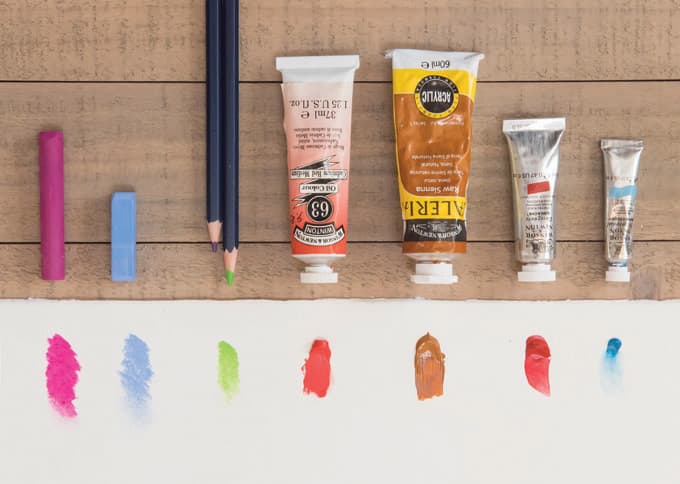 |
|
MEDIUM/ART TOOL |
BINDER |
Watercolor paint |
Gum arabic |
Gouache paint |
Gum arabic |
Acrylic paint |
Acrylic polymer dispersion |
Oil paint |
Oil (such as linseed) |
Colored pencil |
Wax or kaolin clay |
Soft pastel |
Methyl cellulose, gum arabic, or gum tragacanth |
Oil pastel |
Oil and wax |
PAINT TOXICITY
Some paint colors contain toxic metals, so it’s important to handle them with care. Limit contact with your skin and eyes, and avoid inhaling or ingesting them. Below are a few paints with toxicity levels that call for consideration as you paint, with the offending ingredients in parentheses. Remember: If a paint name contains the word “hue,” it is most likely a nontoxic substitute for the original pigment.
• Cadmium red, yellow, and orange (cadmium)
• Cerulean blue (cobalt)
• Chrome green, yellow, and orange (chromates and/or lead)
• Cobalt blue, green, violet, or yellow (cobalt)
• Emerald or Paris green (copper acetoarsenite)
• Flake white (lead)
• Manganese blue and violet (manganese)
• Naples yellow (lead and antimony)
• Vermilion (mercury)
• Zinc sulfide white (zinc sulfide)
• Zinc yellow (chromate)
INORGANIC VS. ORGANIC
There are two basic pigment types: inorganic and organic. Inorganic pigments come from the earth or are manufactured from non-carbon substances. These include earth pigments such as yellow ochre and burnt umber. Synthetic organic pigments are laboratory-created carbon compounds. Sometimes called “modern” pigments, they are often more intense than inorganic pigments. Many of them display beautiful transparency and promising lightfastness (resistance to fading) qualities.
Inorganic pigments:
• Alizarin crimson
• Burnt umber
• Prussian blue
• Raw umber
• Ultramarine blue
• Yellow ochre
Organic pigments:
• Azo yellow
• Hansa yellow
• Perylenes
• Phthalocyanines
• Pyrroles
• Quinacridones
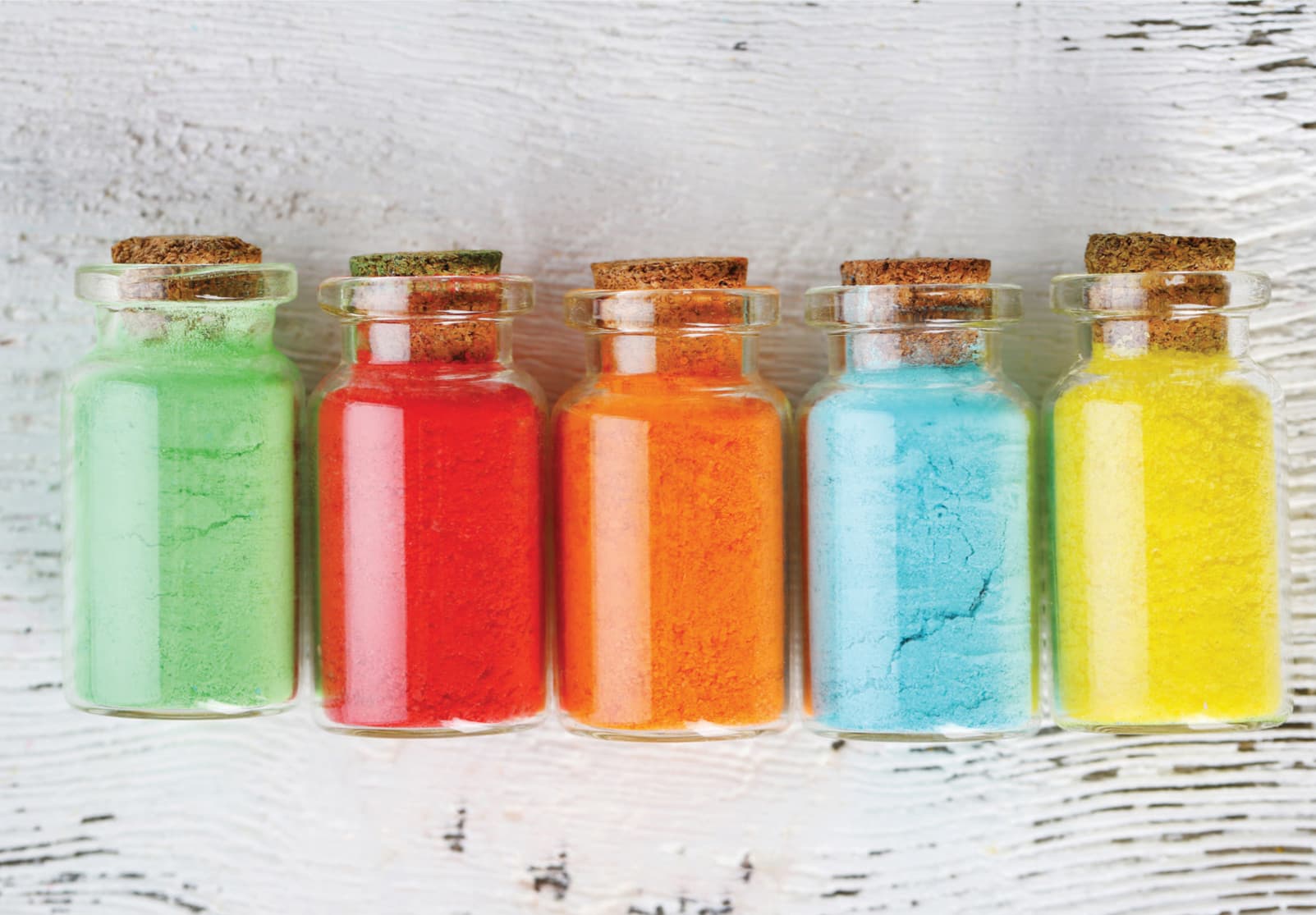
PIGMENT OPACITY
Pigments are characterized as either transparent or semi-transparent, semi-opaque, or opaque. Opaque pigments more effectively block light from hitting the substrate or surface beneath, whereas transparent pigments allow light to pass through and reflect the substrate back to the viewer. Opaques provide more coverage and appear to advance toward the viewer, so they are better suited for foreground objects and highlights. Transparents create luminous and atmospheric effects in paintings and are great for suggesting depth in shadows. Transparents also make wonderful glazes.
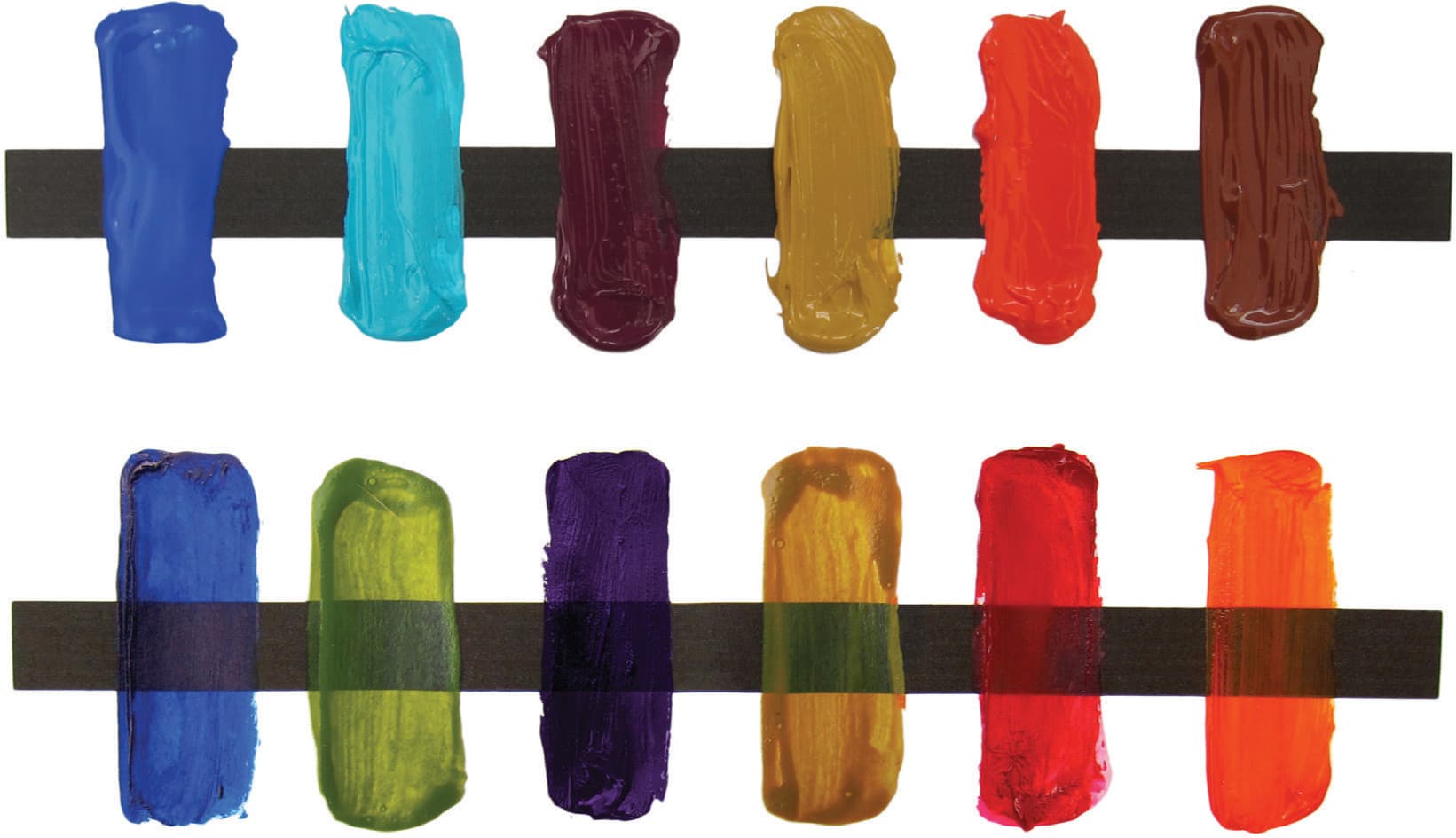
Here you can view highly opaque pigments (top row) versus highly transparent pigments (bottom row). To know the qualities of the pigments in your own palette, it’s a good idea to create a chart like this with your paints. Simply paint a stroke over a black line (such as permanent marker) on your painting surface.
STAINING VS. NONSTAINING
Pigments are classified as staining or nonstaining. Staining pigments, such as alizarin crimson or the phthalocyanines, immediately absorb into the paper’s surface and are impossible to lift or dab away completely. Nonstaining pigments, such as burnt umber or the cadmiums, sit on the surface of the paper and lift away easily. This pigment quality is most relevant to watercolor, particularly when working with techniques that call for dabbing away the pigment. If you want to use staining colors but need the ability to lift them away, you can apply watercolor lifting preparation medium to your paper before applying paint, which makes lifting possible with any pigment.
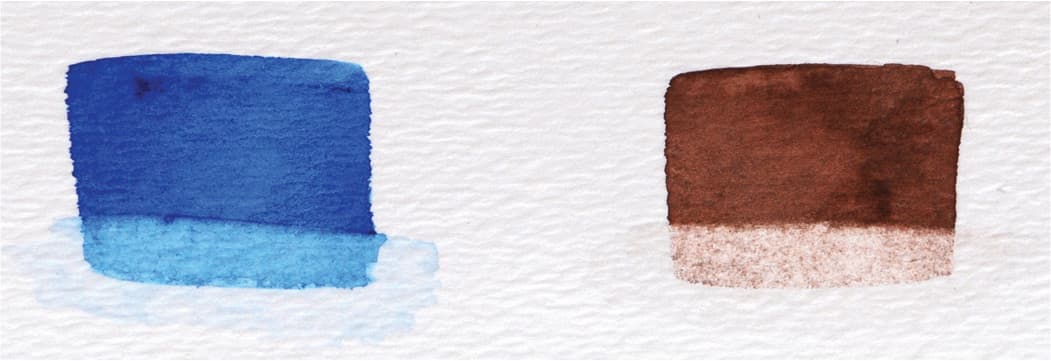
To test the staining quality of a paint, apply a rich stroke of the color to paper and allow it to dry. Use a wet brush to loosen an area of pigment and dab with a paper towel. The more color that remains, the higher the staining quality. Above is a staining test performed with phthalo blue (staining) and burnt umber (nonstaining).
TINTING
When using pigments with a strong tinting quality, a little goes a long way. Knowing the tint strength is helpful when mixing colors; strong paints can overpower those with weak tinting strength, so you will have to adjust your mixes accordingly. Many highly tinting pigments are also highly staining.
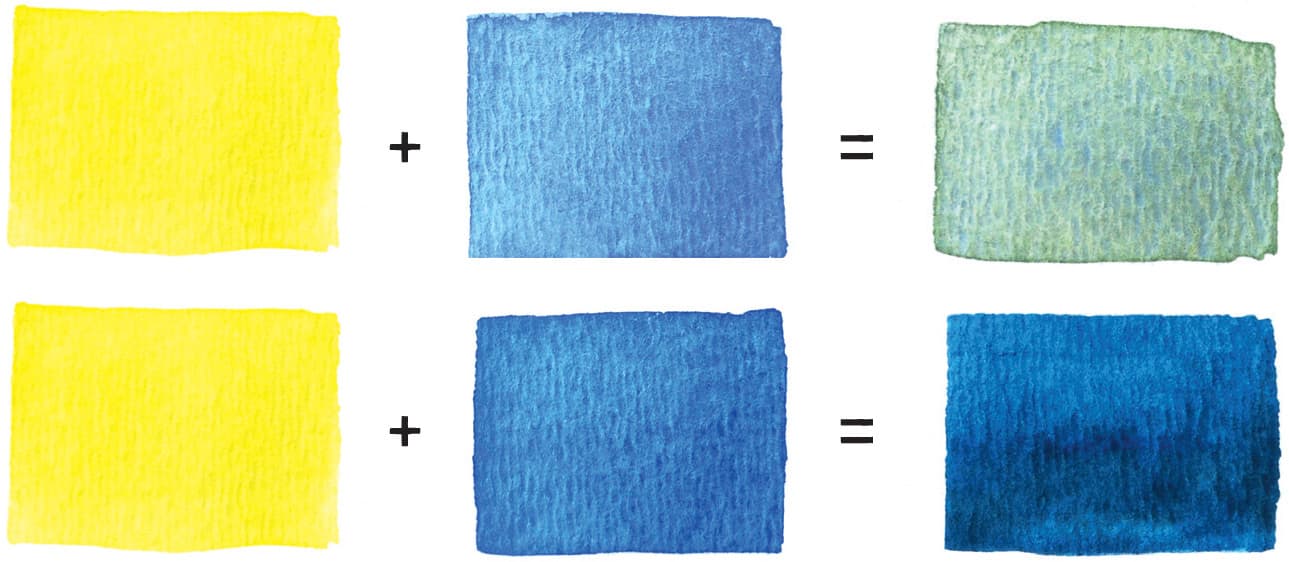
In this example, see how a highly tinting pigment can overpower a pigment of lesser tinting strength. The top row shows lemon yellow mixed with cobalt blue in equal parts (both moderate in tinting strength), which yields a soft green. The bottom row shows lemon yellow mixed with phthalo blue in equal parts. Phthalo blue, a highly tinting pigment, clearly dominates the mix.
MASSTONE VS. UNDERTONE
When assessing a paint, artists often refer to its masstone and undertone. Masstone is the paint as it appears in a thick scoop from the tube, whereas undertone is the paint as it appears thinly over a white support. A pigment’s masstone and undertone can vary quite a bit in hue and value.
LIGHTFASTNESS
Lightfastness refers to the ability of pigment to resist fading over time, particularly when exposed to UV light. Lightfast pigments are not prone to fading and are considered to be more permanent than nonlightfast pigments. Nonlightfast—or fugitive—pigments lighten and lose their intensity quicker. The American Society for Testing and Materials (ASTM) has developed a rating system for lightfastness; a paint’s rating is visible on its tube. It is measured on a scale of I to V, with I and II being the only acceptable ratings for professional artists.
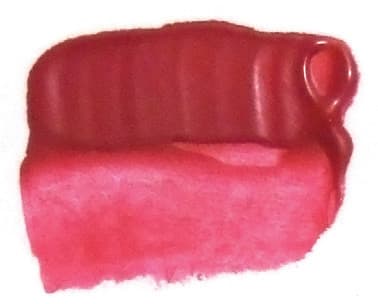
Permanent rose (acrylic)
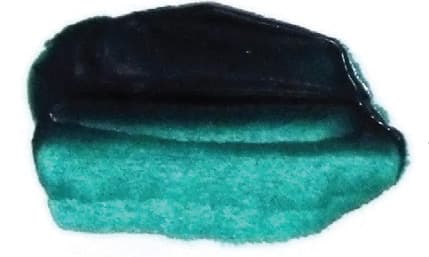
Phthalo green (acrylic)
PAINT VARIATION
Manufacturers offer “hue” varieties of popular paint colors—especially in student-grade paint lines. A hue is not made purely of the pigment specified in the name; instead, it is a mixture of other pigments to match the hue of the original. Manufacturers often do this to reduce cost or toxicity. Paint names, formulations, and properties may also vary between manufacturers; for this reason, many artists are loyal to one brand of paints.
PIGMENT QUALITY CHART
REDS |
|
Swatch |
|
Paint/Pigment Name |
Alizarin crimson |
Color |
blue-leaning red |
Pigment Type |
organic |
Transparency |
transparent |
Staining Ability |
high |
Lightfastness (ASTM) |
II or III |
Swatch |
|
Paint/Pigment Name |
Cadmium red |
Color |
yellow-leaning red |
Pigment Type |
inorganic |
Transparency |
opaque |
Staining Ability |
low |
Lightfastness (ASTM) |
I |
Swatch |
|
Paint/Pigment Name |
Quinacridone red |
Color |
blue-leaning red |
Pigment Type |
synthetic organic |
Transparency |
transparent |
Staining Ability |
high |
Lightfastness (ASTM) |
I |
Swatch |
|
Paint/Pigment Name |
Naphthol red |
Color |
yellow-leaning red |
Pigment Type |
synthetic organic |
Transparency |
semi-opaque |
Staining Ability |
high |
Lightfastness (ASTM) |
I |
Swatch |
|
Paint/Pigment Name |
Perylene red |
Color |
slightly blue-leaning red |
Pigment Type |
synthetic organic |
Transparency |
transparent |
Staining Ability |
medium |
Lightfastness (ASTM) |
I |
Swatch |
|
Paint/Pigment Name |
Pyrrole red |
Color |
yellow-leaning red |
Pigment Type |
synthetic organic |
Transparency |
semi-opaque |
Staining Ability |
high |
Lightfastness (ASTM) |
I |
PURPLES |
|
Swatch |
|
Paint/Pigment Name |
Dioxazine purple |
Color |
blue-leaning violet |
Pigment Type |
synthetic organic |
Transparency |
transparent |
Staining Ability |
high |
Lightfastness (ASTM) |
I |
Swatch |
|
Paint/Pigment Name |
Quinacridone violet / Quinacridone magenta |
Color |
red-leaning violet |
Pigment Type |
synthetic organic |
Transparency |
transparent |
Staining Ability |
medium |
Lightfastness (ASTM) |
I |
BLUES |
|
Swatch |
|
Paint/Pigment Name |
Ultramarine blue |
Color |
red-leaning blue |
Pigment Type |
inorganic |
Transparency |
semi-transparent |
Staining Ability |
low |
Lightfastness (ASTM) |
I |
Swatch |
|
Paint/Pigment Name |
Phthalo blue |
Color |
yellow-leaning or red-leaning |
Pigment Type |
synthetic organic |
Transparency |
transparent |
Staining Ability |
high |
Lightfastness (ASTM) |
I |
Swatch |
|
Paint/Pigment Name |
Manganese blue |
Color |
yellow-leaning blue |
Pigment Type |
inorganic |
Transparency |
transparent |
Staining Ability |
high |
Lightfastness (ASTM) |
I |
Swatch |
|
Paint/Pigment Name |
Cobalt blue |
Color |
slightly yellow-leaning blue |
Pigment Type |
inorganic |
Transparency |
semi-transparent |
Staining Ability |
low |
Lightfastness (ASTM) |
I |
Swatch |
|
Paint/Pigment Name |
Cerulean blue |
Color |
yellow-leaning blue |
Pigment Type |
inorganic |
Transparency |
semi-transparent |
Staining Ability |
low |
Lightfastness (ASTM) |
I |
GREENS |
|
Swatch |
|
Paint/Pigment Name |
Phthalo green |
Color |
blue-leaning green |
Pigment Type |
synthetic organic |
Transparency |
transparent |
Staining Ability |
high |
Lightfastness (ASTM) |
I |
Swatch |
|
Paint/Pigment Name |
Cobalt green |
Color |
yellow-leaning green |
Pigment Type |
inorganic |
Transparency |
semi-transparent |
Staining Ability |
low |
Lightfastness (ASTM) |
I |
Swatch |
|
Paint/Pigment Name |
Terre verte |
Color |
olive green |
Pigment Type |
inorganic |
Transparency |
transparent |
Staining Ability |
low |
Lightfastness (ASTM) |
I |
Swatch |
|
Paint/Pigment Name |
Viridian |
Color |
blue-leaning green |
Pigment Type |
inorganic |
Transparency |
transparent |
Staining Ability |
low |
Lightfastness (ASTM) |
I |
YELLOWS |
|
Swatch |
|
Paint/Pigment Name |
Aureolin |
Color |
primary yellow |
Pigment Type |
inorganic |
Transparency |
transparent |
Staining Ability |
low |
Lightfastness (ASTM) |
II |
Swatch |
|
Paint/Pigment Name |
Hansa yellow / Lemon yellow |
Color |
bright blue-leaning yellow |
Pigment Type |
synthetic organic |
Transparency |
semi-transparent |
Staining Ability |
low to medium |
Lightfastness (ASTM) |
II |
Swatch |
|
Paint/Pigment Name |
Nickel azo yellow |
Color |
brownish yellow |
Pigment Type |
synthetic organic |
Transparency |
transparent |
Staining Ability |
medium |
Lightfastness (ASTM) |
I |
Swatch |
|
Paint/Pigment Name |
Cadmium yellow |
Color |
red-leaning yellow |
Pigment Type |
inorganic |
Transparency |
opaque |
Staining Ability |
low |
Lightfastness (ASTM) |
I |
EARTH COLORS |
|
Swatch |
|
Paint/Pigment Name |
Burnt sienna |
Color |
red-leaning brown |
Pigment Type |
inorganic |
Transparency |
transparent |
Staining Ability |
low |
Lightfastness (ASTM) |
I |
Swatch |
|
Paint/Pigment Name |
Burnt umber |
Color |
red-leaning brown |
Pigment Type |
inorganic |
Transparency |
transparent |
Staining Ability |
low |
Lightfastness (ASTM) |
I |
Swatch |
|
Paint/Pigment Name |
Raw sienna |
Color |
yellow-leaning brown |
Pigment Type |
inorganic |
Transparency |
transparent |
Staining Ability |
low |
Lightfastness (ASTM) |
I |
Swatch |
|
Paint/Pigment Name |
Raw umber |
Color |
varied; often gray-or green-leaning brown |
Pigment Type |
inorganic |
Transparency |
transparent |
Staining Ability |
low |
Lightfastness (ASTM) |
I |
Swatch |
|
Paint/Pigment Name |
Yellow ochre |
Color |
orange-leaning yellow |
Pigment Type |
inorganic |
Transparency |
opaque |
Staining Ability |
low |
Lightfastness (ASTM) |
I |
BLACKS |
|
Swatch |
|
Paint/Pigment Name |
Ivory or bone black |
Color |
warm black |
Pigment Type |
inorganic |
Transparency |
semi-transparent |
Staining Ability |
high |
Lightfastness (ASTM) |
I |
Swatch |
|
Paint/Pigment Name |
Mars black |
Color |
cool black |
Pigment Type |
inorganic |
Transparency |
opaque |
Staining Ability |
high |
Lightfastness (ASTM) |
I |
WHITES |
|
Swatch |
|
Paint/Pigment Name |
Titanium white |
Color |
blue-leaning white |
Pigment Type |
inorganic |
Transparency |
opaque |
Staining Ability |
N/A |
Lightfastness (ASTM) |
I |
Swatch |
|
Paint/Pigment Name |
Zinc white / Chinese white |
Color |
blue-leaning white |
Pigment Type |
inorganic |
Transparency |
semi-opaque |
Staining Ability |
N/A |
Lightfastness (ASTM) |
I |
Note: The colored circles shown are for illustrative purposes only. Actual paint colors may not match exactly due to variations in printing ink. |
|





























